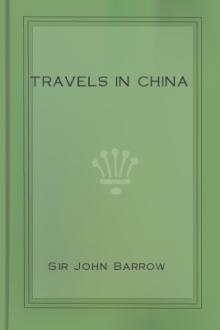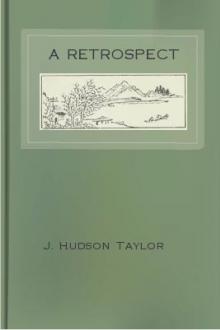Travels in China, Sir John Barrow [phonics readers txt] 📗

- Author: Sir John Barrow
- Performer: -
Book online «Travels in China, Sir John Barrow [phonics readers txt] 📗». Author Sir John Barrow
A pot of bell Metal
The Great Bell of Canton 20 feet diameter 8-16 Inches thick.
A Barrel drum sometimes of Wood & sometimes Metal.
A Log of Wood shaped like a Skull and used in Temples.
A Metal Bell.
A Lyre of silken Strings.
A small Flute.
A Muffled Drum.
The Metal Gong or Loo
Cymbals.
Uncertain
A Pair of Rattles or Castanets.
Cymbals struck with a rod.
Alommon Flute.
Two Stringed Violins
A Three Stringed Guitar.
A Pipe of inequal reeds or bamboos.
Four Stringed Guitars.
Three Trumpets.
A Lyre of 11 Metallic Strings.
Metal Plates an Instrument used in Sacred Music.
A small barrell Drum.
A fixed Drum used in Sacred Music.
A small Gong or Loo.
A Chinese band generally plays, or endeavours to play, in unison, and sometimes an instrument takes the octave; but they never attempt to play in separate parts, confining their art to the melody only, if I may venture to apply a name of so much sweetness to an aggregation of harsh sounds. They have not the least notion of counter-point, or playing in parts: an invention indeed to which the elegant Greeks had not arrived, and which was unknown in Europe as well as Asia, until the monkish ages.
I never heard but one single Chinese who could be said to sing with feeling or plaintiveness. Accompanied with a kind of guittar, he sung the following air in praise of the flower Moo-lee, which it seems is one of the most popular songs in the whole country. The simple melody was taken down by Mr. Hittner, and I understand has been published in London, with head and tail-pieces, accompaniments, and all the refined arts of European music; so that it ceases to be a specimen of the plain melody of China. I have therefore given it in its unadorned state, as sung and played by the Chinese, together with the words of the first stanza, and their literal translation.
Hau ye-to sien wha,
678910111213
Yeu tchau yeu jie lo tsai go kia
141516171819
Go pun tai, poo tchoo mun
202122232425
Twee tcho sien wha ul lo.
Hau ye to Moo-lee-wha
7891011121314
Man yuen wha kai soy poo quee ta
151617181920
Go pun tai tsai ye ta
21222324252627
Tai you kung kan wha jin ma.
How delightful this branch of fresh flowers
678910111213
One morning one day it was dropped in my house
141516171819
I the owner will wear it not out of doors
202122232425
But I will hold the fresh flower and be happy.
How delightful this branch of the Moo-lee flower
7891011121314
In the full plot of flowers blowing freely none excels it
151617181920
I the owner will wear this gathered branch
21222324252627
Wear it yet fear, the flower seen, men will envy.
I have thought it not amiss to subjoin a few other airs of the popular kind, which were written by the same gentleman at Canton, who made the drawings of their musical instruments.
They have no other notion of noting down music than that of employing a character expressing the name of every note in the scale; and even this imperfect way they learned from Pereira the Jesuit. They affected to dislike the Embassador's band which they pretended to say produced no music, but a confusion of noises; yet the Emperor's chief musician gave himself a great deal of trouble in tracing out the several instruments on large sheets of paper, each of its particular size, marking the places of the holes, screws, strings, and other parts, which they conceived necessary to enable them to make others of a similar construction.
It would be difficult to assign the motive that induced Father Amiot to observe, that "the Chinese, in order to obtain their scale of notes or gamut perfect, were not afraid of submitting to the most laborious operations of geometry, and to the most tedious and disgusting calculations in the science of numbers;" as he must have known, that they were altogether ignorant of geometry, and that their arithmetic extended not beyond their Swan-pan. Of the same nature is the bold and unfounded assertion of another of the Jesuits, "that the musical system of the Chinese was borrowed from them by the Greeks and Egyptians, anterior to the time of Hermes or Orpheus!"
With regard to painting, they can be considered in no other light than as miserable daubers, being unable to pencil out a correct outline of many objects, to give body to the same by the application of proper lights and shadows, and to lay on the nice shades of colour, so as to resemble the tints of nature. But the gaudy colouring of certain flowers, birds, and insects, they imitate with a degree of exactness and brilliancy to which Europeans have not yet arrived. To give distance to objects on canvas, by diminishing them, by faint colouring, and by perspective, they have no sort of conception. At Yuen-min-yuen I found two very large paintings of landscapes which, as to the pencilling, were done with tolerable execution, but they were finished with a minuteness of detail, and without any of those strong lights and masses of shade, which give force and effect to a picture; none of the rules of perspective were observed, nor any attempt to throw the objects to their proper distances; yet I could not help fancying that I discovered in them the hand of an European. The old eunuch, who carried the keys of the room, frequently asked me, when looking at these pictures, if I did not think his countrymen were excellent painters; and having one day expressed great admiration for the talents of the artist, he led me into a recess of the room, and opening a chest, supported upon a pedestal, he observed, with a significant look, he was now going to produce something that would astonish me. He then took out several large volumes, which were full of figures, drawn in a very superior style and tinted with water colours, representing the several trades and occupations carried on in the country; but they seemed to be stuck against the paper, having neither shadow nor foreground, nor distance, to give them any relief. On the opposite page to each figure was a description, in the Mantchoo Tartar and the Chinese languages. Having turned over one of the volumes, I observed, on the last page, the name of Castaglione, which at once solved the riddle. On re-examining the large pictures in the hall, I found the same name in the corner of each. While going through the volume, the old eunuch frequently asked, if any one in Europe could paint like the Chinese? but, on my pointing to the name, and repeating the word Castaglione, he immediately shut the book and returned them all into the chest, nor, from that time, could I ever prevail upon him to let me have another sight of them. On enquiry, I found that Castaglione was a missionary in great repute at court, where he executed a number of paintings, but was expressly directed by the Emperor to paint all his subjects after the Chinese manner, and not like those of Europe, with broad masses of shade and the distant objects scarcely visible, observing to him, as one of the missionaries told me, that the imperfections of the eye afforded no reason why the objects of nature should also be copied as imperfect. This idea of the Emperor accords with a remark made by one of his ministers, who came to see the portrait of His Britannic Majesty, "that it was great pity it should have been spoiled by the dirt upon the face," pointing, at the same time, to the broad shade of the nose.
Ghirrardini, an European painter, published an account of his voyage to China, where, it appears, he was so disgusted that, having observed how little idea they possess of the fine arts, he adds, with rather more petulancy than truth, "these Chinese are fit for nothing but weighing silver, and eating rice." Ghirrardini painted a large colonnade





Comments (0)